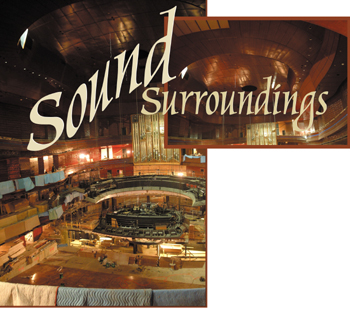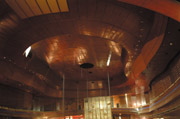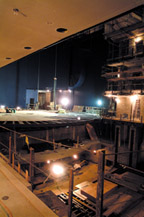

Destined to be the facility of choice for symphonic recordings and host to international orchestras, the Kimmel, aka the Regional Performing Arts Center, is the latest in acoustical and construction projects to share the same caliber of acoustical achievement with such halls as Boston Symphonic, Vienna's Hofburg and the Consort Amsterdam. If money talks, the RPAC sings the credits of all the major players in the acoustic, architectural, engineering and construction worlds. At its debut show in December 2001, Elton John introduced the venue with a set to the $5,000-a-plate patrons for its debut Christmas gala.
Taking up one whole city block located in Center City Philadelphia, the RPAC is found on the Avenue of the Arts, just adjacent to the University of the Arts and within walking distance to the Academy of Music and the Curtis Institute of Music. The project size has a footprint of 100,075 square feet, with a gross program area of 429,085 square feet.

Contractor coda
The building is divided into two major standing facilities: the 2,500-seat stadium Verizon Hall will be the new home of the Philadelphia Orchestra, and the 650-seat Perelman Theater, designed for performances in dance and drama. Nestled between the two halls is the Commonwealth Plaza to serve as the civic space for outdoor cafe-style arrangements. The exterior shell to these venues is a half of a vaulted barrel, made of pure glass. This frame alone is an architectural achievement and will only help increase the hall's traffic.Here's what the facility consists of and what it took:
o 490,000 square feet of performance space.
o 2,500 seats in the main performance hall.
o 650 seats in the rehearsal hall.
o More than 1 million man hours of skilled labor.
o 45 contractors and subcontractors.
o 317,000 masonry blocks.
o 29,054 cubic yards of concrete.
o 3,700 tons of structural steel.
o 160 tons of steel studs, track and lath.
o 2,281 tons of rebar.
o 156,677 square feet of glass glazing.
o 61,048 linear feet of structural steel tubing used in glass roof supports.
o 1,400 tons of steel arches support the glass end walls.
o More than 100 tons of plaster.
How much is that worth? A lot. Especially when the powers to be contract the work out to international players like Rafael Vinoly Architects PC, of New York, and acoustician Russell Johnson, of Artec Consultants Inc., also of New York. The general contractor that landed the estimated $265 million job among the 45 contractors and subcontractors, was Duggan and Marcon Inc., of Bethlehem, Pa. D&M was contracted to install, for the most part, the interior work to Verizon and Perelman halls.
Five-years in the making, the grocery list is an exhaustive roster of industry names and materials:
o USG: 104, 096 square feet of Fiberock, 636,108 square feet of Sheetrock and Shaftwall and more than 100 tons of the company's plaster lines.
o Georgia-Pacific: 68,000 square feet of Dens-Glass Gold.
o Unimast: 160 tons of steel studs, track and lath.
o Weyerhaeuser: 42,068 lineal feet of lumber.
"The building consists of masonry construction of one city block covered with a glass-barrel roof," says Charlie Marcon, co-owner of D&M. "It was under planning and design for more than five years prior to construction, from planning to occupancy."
The company got involved through the construction manager LF Driscoll, a large Philadelphia-based construction management firm.
"Being in the construction market in Philadelphia, you had to know about it," continues Marcon.

The cellists' ceiling
Considering the manpower and materials used to build the RPAC, it was important for the project to operate like a machine. Coordinating the balance of material supply and vacancy was work contracted out to George F. Kempf Supply, of Philadelphia.Kempf's role wasn't strictly the same hours as the rest of the construction, which worked around the clock. The supply company's timetable was under a state of constant flux and irregular hours. More than once, calls were placed for a Sunday delivery; emergency runs were plentiful. The company, to its credit, was unconditionally accommodating. Such behind-the-scenes service enabled plenty of the on-site workers to work without pause and material always at hand. Like all major projects, a serious and important deadline was to be met.
"Our role was not only just-in-time delivery, but to handle the products on the job," says George F. Kempf's President Bob Kempf. "By distributing the material around the job site, we move the stuff around so we don't wipe out the carpenters and we get the material close enough--so they don't waste a lot of time moving it around."
Emergencies and accidents are always a threat. LF Driscoll employed a full-time safety consultant, as well as D&W's own Patrick Staub. It was important to meet OSHA compliance for the 80-foot high scaffold erected inside the Verizon.
"The scaffold in the concert hall alone was $550,000," says Marcon. "It was in place approximately eight months and took six weeks to build."
Elevation to those heights helped for all the assembly of the wall system, as well as complex and very meticulous detail for a complex acoustical system. The walls are both plaster and drywall. Above the pit and pendulum is the major ceiling of the Verizon. It is shaped like a cello. What composes the ceiling are layers of plaster, furring strips, wood, glue and plastic.
"We framed the ceiling steel angles, furring channels and metal lath," says Marcon. "We installed wood grounds at the perimeter of each wood panel. We plastered in between the wood grounds on the face of the metal lath 3/4 inch of plaster and we back plastered lath of a thickness of 2 1/4-inch of plaster, to make a total of 3 inches."
"For the ceiling (panels), they need to be as heavy, stiff and mass as possible, in order to reflect sounds," says Christopher Storch, director of acoustic consulting services, Artec Consulting. "Since the architects did not want a plaster, but a wood surface, we had to make the wood as dense underneath as possible."
A 3-D model was used to preview how they would work the ceiling into place. All the wood panels were pre-cut to fit on the furring and glued the fields to the plaster.
"We applied glue to the wood panel and we screwed the wood panel to the furring," says Marcon. "The acoustician insisted that there are no voids between the plaster and the wood.
"After all this was done--this is the good part--the acoustical consultant inspected the ceiling with a hammer, tapped 6-inch increments," he continues. "If he found a hollow spot, we had to drill a hole and inject plastic into the less dense areas of the wood. The instrument used to fill in these spots was like a hypodermic needle!"
For optimal sound quality and control, one of the outstanding features the Verizon has are the reverberation chambers: 114 motor-powered doors that are automatically opened and closed to enhance volume, adjust reverberation time and help tune the performance center. The doors, constructed out of steel channels and angles, are 6 to 14 feet wide. For similar acoustical reasons, the doors had to be custom made as thick as the ceilings--if not more. The face of the door is 3/4-inch plywood and then a 3/4-inch face panel. On the back of the door are three layers of 3/4-inch Fiberock.
The reasons for a dense sound hall extend beyond acoustic and sound issues. The building had to be built thick for sound isolation, in particular the challenge of channeling out noise levels from a nearby subway station. To shield the concert center from the train, both the Verizon and Perelman theaters were built on rubber isolation pads.
"It needs to act as one monolithic piece," says Storch. "And if it's hollow, that sound gets reflected back."
All companies worked their ways out the door. Marcon was doing wrap-up the morning of the first performance. Members of his staff were working 16-hour days to ensure project completion by Dec. 14. D&M's typical job has been convention centers and banks around the Philadelphia metropolitan area, but a concert facility poses different challenges from previous work. Constructing a sound facility that is of the highest quality while maintaining the look that needs to match that sound is tremendously demanding and a large undertaking.
"Jobs like this expect us to exceed our last performance," says Kempf. "We had to do all the demanding things for this job: night work, training material, emergency deliveries--there was a lot of chaos."
"This was certainly intense," says Marcon, "but still a once-in-a-lifetime opportunity."




